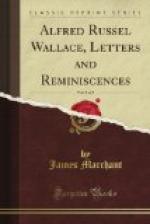My dear Meldola,— ... I am now reading a wonderfully interesting book—O. Fisher’s “Physics of the Earth’s Crust.” It is really a grand book, and, though full of unintelligible mathematics, is so clearly explained and so full of good reasoning on all the aspects of this most difficult question that it is a pleasure to read it. It was especially a pleasure to me because I had just been writing an article on the Permanence of the Oceanic Basins, at the request of the Editor of Natural Science, who told me I was not orthodox on the point. But I find that Fisher supports the same view with very great force, and it strikes me that if weight of argument and number of capable supporters create orthodoxy in science, it is the other side who are not orthodox. I have some fresh arguments, and I was delighted to be able to quote Fisher. It seems almost demonstrated now that Sir W. Thomson was wrong, and that the earth has a molten interior and a very thin crust, and in no other way can the phenomena of geology be explained....—Yours very truly,
ALFRED R. WALLACE.
* * * * *
TO SIR OLIVER LODGE
Parkstone, Dorset. March 8, 1898.
My dear Sir,—My own opinion has long been—and I have many times given reasons for it—that there is always an ample amount of variation in all directions to allow any useful modification to be produced, very rapidly, as compared with the rate of those secular changes (climate and geography) which necessitate adaptation; hence no guidance of variation in certain lines is necessary. For proof of this I would ask you to look at the diagrams in Chapter III. of my “Darwinism,” reading the explanation in the text. The proof of such constant indefinite variability has been much increased of late years, and if you consider that instead of tens or hundreds of individuals, Nature has as many thousands or millions to be selected from, every year or two, it will be clear that the materials for adaptation are ample.
Again, I believe that the time, even as limited by Lord Kelvin’s calculations, is ample, for reasons given in Chapter X., “On the Earth’s Age,” in my “Island Life,” and summed up on p. 236. I therefore consider the difficulty set forth on p. 2 of the leaflet you send is not a real one. To my mind, the development of plants and animals from low forms of each is fully explained by the variability proved to exist, with the actual rapid multiplication and Natural Selection. For this no other intellectual agency is required. The problem is to account for the infinitely complex constitution of the material world and its forces which rendered living organisms possible; then, the introduction of consciousness or sensation, which alone rendered the animal world possible; lastly, the presence in man of capacities and moral ideas and aspirations which could not conceivably be produced by variation and Natural Selection. This is stated at p. 473-8 of my “Darwinism,” and is also referred to in the article I enclose (at p. 443) and which you need not return.




